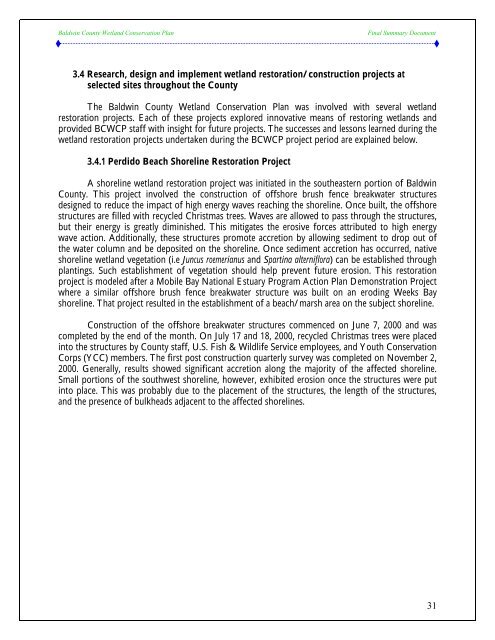Baldwin County Wetland Conservation Plan - Alabama Department ...
Baldwin County Wetland Conservation Plan - Alabama Department ...
Baldwin County Wetland Conservation Plan - Alabama Department ...
You also want an ePaper? Increase the reach of your titles
YUMPU automatically turns print PDFs into web optimized ePapers that Google loves.
<strong>Baldwin</strong> <strong>County</strong> <strong>Wetland</strong> <strong>Conservation</strong> <strong>Plan</strong> Final Summary Document<br />
3.4 Research, design and implement wetland restoration/construction projects at<br />
selected sites throughout the <strong>County</strong><br />
The <strong>Baldwin</strong> <strong>County</strong> <strong>Wetland</strong> <strong>Conservation</strong> <strong>Plan</strong> was involved with several wetland<br />
restoration projects. Each of these projects explored innovative means of restoring wetlands and<br />
provided BCWCP staff with insight for future projects. The successes and lessons learned during the<br />
wetland restoration projects undertaken during the BCWCP project period are explained below.<br />
3.4.1 Perdido Beach Shoreline Restoration Project<br />
A shoreline wetland restoration project was initiated in the southeastern portion of <strong>Baldwin</strong><br />
<strong>County</strong>. This project involved the construction of offshore brush fence breakwater structures<br />
designed to reduce the impact of high energy waves reaching the shoreline. Once built, the offshore<br />
structures are filled with recycled Christmas trees. Waves are allowed to pass through the structures,<br />
but their energy is greatly diminished. This mitigates the erosive forces attributed to high energy<br />
wave action. Additionally, these structures promote accretion by allowing sediment to drop out of<br />
the water column and be deposited on the shoreline. Once sediment accretion has occurred, native<br />
shoreline wetland vegetation (i.e Juncus roemerianus and Spartina alterniflora) can be established through<br />
plantings. Such establishment of vegetation should help prevent future erosion. This restoration<br />
project is modeled after a Mobile Bay National Estuary Program Action <strong>Plan</strong> Demonstration Project<br />
where a similar offshore brush fence breakwater structure was built on an eroding Weeks Bay<br />
shoreline. That project resulted in the establishment of a beach/marsh area on the subject shoreline.<br />
Construction of the offshore breakwater structures commenced on June 7, 2000 and was<br />
completed by the end of the month. On July 17 and 18, 2000, recycled Christmas trees were placed<br />
into the structures by <strong>County</strong> staff, U.S. Fish & Wildlife Service employees, and Youth <strong>Conservation</strong><br />
Corps (YCC) members. The first post construction quarterly survey was completed on November 2,<br />
2000. Generally, results showed significant accretion along the majority of the affected shoreline.<br />
Small portions of the southwest shoreline, however, exhibited erosion once the structures were put<br />
into place. This was probably due to the placement of the structures, the length of the structures,<br />
and the presence of bulkheads adjacent to the affected shorelines.<br />
31

















